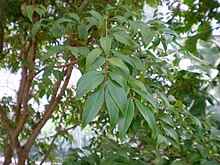Jabuticaba
| Jabuticaba | |
|---|---|

| |
| Scientific classification | |
| Kingdom: | |
| (unranked): | |
| (unranked): | |
| (unranked): | |
| Order: | |
| Family: | |
| Genus: | |
| Species: | M. cauliflora
|
| Binomial name | |
| Myrciaria cauliflora (Mart.) O.Berg
| |
The Jabuticaba (also called Brazilian Grape Tree, Jaboticaba, Jabotica, Guaperu, Guapuru, Hivapuru, Sabará and Ybapuru) is a fruit-bearing tree native to Brazil. The fruit is purplish black, with a white pulp; it can be eaten raw or be used to make jellies and drinks (plain juice or wine).

The fruit tree (named jabuticabeira in Portuguese) has salmon-colored leaves when they are young, turning green posteriorly. It is a very slow growing tree which prefers moist, lightly acidic soils for best growth. It is widely adaptable, however, and grows satisfactorily even on alkaline beach-sand type soils, so long as they are tended and irrigated. Its flowers are white and grow directly from its trunk in a cauliflorous habit. Naturally the tree may flower and fruit only once or twice a year, but when continuously irrigated it flowers frequently, and fresh fruit can be available year round in tropical regions.
The jabuticaba (Myrciaria cauliflora (Mart.) O.Berg. [Myrtaceae]) is a small tree native to the Minas Gerais region near Rio de Janeiro in southern Brazil grown for the purple, grape-like fruits it produces. Traditionally, an astringent decoction of the sun-dried skins has been used as a treatment for hemoptysis, asthma, diarrhea, and gargled for chronic inflammation of the tonsils. The fruit is 3-4 cm in diameter with one to four large seeds, borne directly on the main trunks and branches of the plant, lending a distinctive appearance to the fruiting tree. It has a thick, purple, astringent skin that covers a sweet, white, or rosy pink gelatinous flesh. Common in Brazilian markets, jaboticabas are largely eaten fresh; their popularity has been likened to that of grapes in the US. Fresh fruit may begin to ferment 3 to 4 days after harvest, so they are often used to make jams, tarts, strong wines, and liqueurs.
Several potent antioxidant and anti-inflammatory anti-cancer compounds have been isolated from the fruit.[1]

File:IMG 2734 (Large).JPG In Brazil the fruit of several species, namely M. jaboticaba (Vell.) O.Berg, M. tenella (DC.) O.Berg, and M. trunciflora O.Berg, share the same common name.
The name is derived from the Tupi word Jabuti (tortoise) + Caba (place), meaning the place where you find tortoises.
Cultural aspects
The tree appears as a charge in the arms of Contagem, Minas Gerais, Brazil[2].
References
External links
- Jaboticaba California Rare Fruit Growers
- Jaboticaba Features and growing conditions
